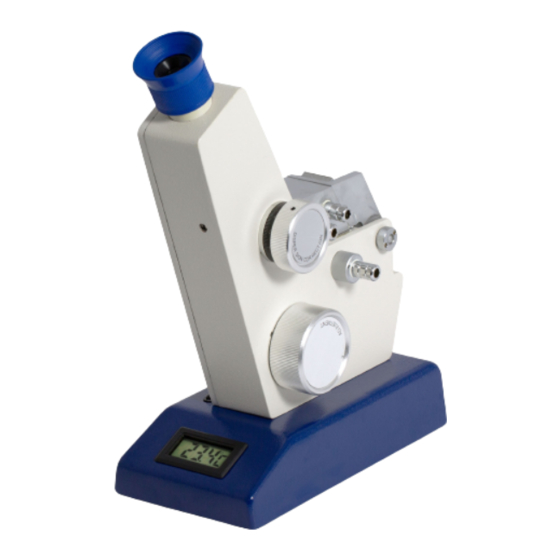
Inhaltszusammenfassung für PCE Instruments AR3
- Seite 1 Abbe-Refraktometer Betriebsanleitung AR3 | AR4 (mit Beleuchtungseinheit) Abbe Refractometer Operating Manual AR3 | AR4 (with Illumination Unit) www.pce-instruments.com/deutsch...
-
Seite 2: Inhaltsverzeichnis
Inhaltsverzeichnis Inhalt DEUTSCH 1. Bedien- und Anschlusselemente 2. Anwendungsgebiete 3. Inbetriebnahme 4. Kalibrierung 4.1 Kalibrierung mit Kalibrierkörpern 4.2 Kalibrierung mit destilliertem Wasser 5. Messung von Flüssigkeiten 6. Messung von Feststoffen 7. Ermittlung des Dispersionswertes 8. Besondere Hinweise 9. Technische Daten 10. - Seite 3 Index Index ENGLISH 1. Handling and connection part 2. Applications 3. Setting up 4. Calibration 4.1 Calibration with standard solids 4.2 Calibration with distilled water 5. Measuring Liquids 6. Measuring Solids 7. Calculation of the Dispersion 8. Special Instructions 9. Technical Data 10.
-
Seite 4: Bedien- Und Anschlusselemente
1. Bedien- und Anschlusselemente 1. Bedien- und Anschlusselemente Okular Kompensatorknopf Thermostateingang Beleuchtungsprisma Thermostatausgang Beleuchtungsprisma Justierschraube Thermostatausgang Messprisma Triebknopf Display (Temperaturanzeige) - Seite 5 1. Bedien- und Anschlusselemente Beleuchtungsprisma Verriegelungsknopf Beleuchtungsansatz Skalenbeleuchtungs- anschluss Klappspiegel Thermometeraufnahme Skalenbeleuchtung Thermostateingang Messprisma Netzanschlussbuchse Buchse für Beleuchtungskabel Stereobuchse für Temperaturfühler...
-
Seite 6: Anwendungsgebiete
2. Anwendungsgebiete / 3. Inbetriebnahme 2. Anwendungsgebiete Das Gerät misst den Brechungsindex nD, den Trocken- substanzgehalt in % und den Dispersionswert nF-nC von transparenten und opaken Flüssigkeiten oder Fest- körpern. In Verbindung mit einem Thermostaten misst das Instrument den Brechungsindex im Bereich von 0–70 °C. - Seite 7 3. Inbetriebnahme Schrauben Sie die Platte des Beleuchtungskabels mit der Rändelschraube am Beleuchtungsansatz fest. Schließen Sie das Beleuchtungskabel an die entsprech- enden Buchsen am Gerät an Schrauben Sie den Thermofühler des digitalen Ther- mometers mit seinem Dichtring in die Thermometerauf- nahme und verbinden Sie das andere Ende des Kabels mit der Stereobuchse unten Die Konstanthaltung der Temperatur ist für hoch genaue...
-
Seite 8: Kalibrierung
4. Kalibrierung 4. Kalibrierung Vor der Messung sollte die Kalibrierung der Skala über- prüft werden. Zwei Möglichkeiten werden nachfolgend beschrieben. 4.1 Kalibrierung mit Kalibrierkörpern Den Verriegelungsknopf im Uhrzeigersinn drehen und das Beleuchtungsprisma anheben. Einige Tropfen Kon- taktflüssigkeit auf das Messprisma geben. Den Kalibrier- körper mit der polierten Fläche auf das Messprisma legen. -
Seite 9: Kalibrierung Mit Destilliertem Wasser
5. Messung von Flüssigkeiten 4.2 Kalibrierung mit destilliertem Wasser Die vorstehend genannte Methode ist theoretisch die genauere, aber die nachfolgend beschriebene ist ein- facher zu handhaben und wird deshalb oft angewendet. Statt des Steines mit der Kontaktflüssigkeit einige Tropfen destilliertes Wasser auf das Messprisma geben. Ansonsten wie bei der vorigen Methode verfahren, mit der Ausnahme, das ein Brechungsindex von 1,3330 nD oder 0 %Brix auf der Skala eingestellt wird. -
Seite 10: Messung Von Feststoffen
6. Messung von Feststoffen 6. Messung von Feststoffen Eine Fläche des zu untersuchenden Körpers muß eben und glatt sein. Ein Tropfen Kontaktflüsssigkeit auf das Messprisma geben und den Körper mit der ebenen Fläche leicht auf das Messprisma drücken, es dürfen keine Luftblasen eingeschlossen werden. -
Seite 11: Ermittlung Des Dispersionswertes
7. Ermittlung des Dispersionswertes 7. Ermittlung des Dispersionswertes Der Dispersionswert wird durch die Anwendung der folgenden Formel berechnet: nF - nC = A + B x a In Tabelle 2 sind die Werte für A und B den Brechungs- indizes zugeordnet. Zwischenwerte sind durch Interpola- tion zu erhalten. -
Seite 12: Besondere Hinweise
8. Besondere Hinweise Beispiel zur Ermittlung des Dispersionswertes: Brechungsindex nD = 1,4827 (gemessen) Werte des Skalenringes: 1. Position 2. Position 42,3 42,2 42,2 42,1 42,2 42,3 42,2 42,2 --------------------------------- Mittelwert Z = 42,2 Ermittlung: = 1,4827 (gemessen) = 42,2 (gemittelt) = 0,024265 (aus Tabelle) = 0,024670 (aus Tabelle) = - 0,5962 (aus Tabelle) -
Seite 13: Technische Daten
8. Besondere Hinweise / 9. Technische Daten ► Eine hochzähe Lösung, die einige Zeit gestanden hat, kann an der Oberfläche einen anderen Brechungsindex als am Boden aufweisen. Die Präparate sollten immer gut verrührt und vermischt sein. ► Das Präparat muß den größten Teil des Messprismas be- netzen, da sonst keine klare Hell-Dunkel-Teilung entstehen kann. -
Seite 14: Tabellen
10. Tabellen 10. Tabellen Tabelle 1 Brechungsindex und Dispersion von destilliertem Wasser in Abhängigkeit von der Temperatur. °C nF - nC °C nF - nC 1,33369 0,00600 1,33240 0,00596 1,33364 0,00600 1,33229 0,00595 1,33358 0,00599 1,33217 0,00595 1,33352 0,00599 1,33206 0,00594 1,33346 0,00599... - Seite 15 10. Tabellen 1,38000 0,02458 0,02768 0,914 1,39000 0,02454 0,02746 0,891 1,40000 0,02450 0,02722 0,866 1,41000 0,02446 0,02696 0,839 1,42000 0,02443 0,02670 0,809 1,43000 0,02440 0,02641 0,777 1,44000 0,02437 0,02612 0,743 1,45000 0,02434 0,02580 0,707 1,46000 0,02431 0,02547 0,669 1,47000 0,02429 0,02513 0,629 1,48000...
-
Seite 16: Fehlersuche
11. Fehlersuche 11. Fehlersuche Helle Abbildung, Spiegel heruntergeklappt ► Klappen Sie den Spiegel hoch wenig Kontrast Beleuchtungsprisma liegt nicht parallel auf dem Messprisma ► Beleuchtungsprisma lösen, justieren und befestigen Zu wenig Probe aufgetragen ► Menge der Probe erhöhen Oberfläche des Messprismas beschädigt ►... -
Seite 17: Durchflusszelle
12. Durchflusszelle 12. Durchflusszelle Das Gerät kann mit einer Durchflusszelle versehen werden. Wir bieten die Trichterdurchflusszelle AR15 oder die Pumpendurchflusszelle AR16 an. Bei beiden entsteht ein kontinuierlicher Probenfluss. Die Montage der Durchflusszelle ist für beide Modelle gleich. -
Seite 18: Garantiebestimmungen
13. Garantiebestimmungen 13. Garantiebestimmungen A.KRÜSS Optronic übernimmt die Garantie für Material und Herstellung der Abbe Refraktometer für einen Zeitraum von 24 Monaten, gerechnet ab Datum des Versands. Während dieser Garantiezeit wird A.KRÜSS Optronic Mängel durch Reparatur oder Austausch beheben, wenn diese unter den Garantieanspruch fallen. Für Garantiereparaturen oder Service muss das Gerät an A.KRÜSS Optronic zurück - gesandt werden. -
Seite 19: Ihre Meinung Interessiert Uns
Garantieverlängerung Ihre Meinung interessiert uns! Wir gewähren Ihnen 1 Jahr Garantieverlängerung bei Rücksendung des vollständig ausgefüllten und zurückgesandten Fragebogens! Firma Ansprechpartner Email Anschrift Seriennummer Wurde der Liefertermin eingehalten? nein War die Inbetriebnahme problemlos? nein Sie sind bereits Kunde Neukunde Sie sind Händler Endkunde Universität/Institut...










